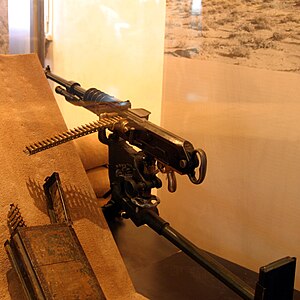Hotchkiss M1914
| Hotchkiss M1914 | |
|---|---|
|
Hotchkiss Mle 14
|
|
| Type | Medium machine gun |
| Place of origin | France |
| Service history | |
| In service | 1914–1960s |
| Used by | See Users |
| Wars |
Mexican Revolution World War I Polish–Soviet War World War II Second Italo-Ethiopian War Spanish Civil War Second Sino-Japanese War First Indochina War Algerian War |
| Production history | |
| Designer | A. Odkolek von Augeza Laurence V. Benét Henri Mercié. |
| Designed | 1897 (M1897), 1900 (M1900) |
| Produced | 1914–20 (M1914) |
| Number built | over 65,000 |
| Variants | M1897 M1900 M1914 |
| Specifications | |
| Weight | 53 lb 11 oz (24.4 kg) |
| Length | 1390 mm (55 in) |
| Barrel length | 787 mm (31 in) |
|
|
|
| Cartridge |
8×50R Lebel 7×57mm Mauser 6.5×50mmSR Arisaka 11 mm Gras 6.5×55mm |
| Caliber | 8 mm |
| Action | gas-actuated |
| Rate of fire | 450-600 round/min |
| Muzzle velocity | 2,375 ft/s (724 m/s) |
| Feed system | 30 round strip articulated metal belt |
The Mle 1914 Hotchkiss machine gun chambered for the 8mm Lebel cartridge became the standard machine gun of the French Army during World War I. It was manufactured by the French arms company Hotchkiss et Cie, which had been established in the 1860s by American industrialist Benjamin B. Hotchkiss. The gas-actuated Hotchkiss system was first formulated in 1895 by Odkolek von Ujezda and improved into its final form by Hotchkiss armament engineers Laurence Benét and Henri Mercié.
The Mle 1914 was the last version of a series of nearly identical Hotchkiss designs : the Mle 1897, Mle 1900 and the Mle 1909. The Hotchkiss Mle 1914 became the French infantry standard in late 1917, replacing the unreliable St. Étienne Mle 1907. The American Expeditionary Forces (AEF) in France also purchased 7,000 Mle 1914 Hotchkiss machine guns in 8mm Lebel, and used them extensively at the front in 1917 and 1918. Hotchkiss heavy machine guns, some being of earlier types, were also used in combat by Japan, Chile, Mexico, Spain, Belgium, Brazil and Poland.
The Hotchkiss machine gun, a sturdy and reliable weapon, remained in active service with the French army until the early 1940s. By the end of 1918, 47,000 Hotchkiss machine guns had already been delivered to the French army alone. If one includes all the international sales, the grand total of all Hotchkiss machine guns sold by the manufacturer in various calibers is well in excess of 100,000 units.
The Hotchkiss was based on a design by Captain Baron Adolf Odkolek von Ujezda of Vienna. The patents had been purchased in 1893 by the firm of Benjamin Hotchkiss, based in Saint-Denis, near Paris. Benjamin Hotchkiss was no longer alive at the time of the purchase, but the Odkolek design was further developed and greatly improved under the direction of American-born Laurence Vincent Benét (1863–1948) with the assistance of Henri Albert Mercié. After trials that began in 1895, development issues were resolved leading to the initial purchase of the Hotchkiss gun by the French Military in 1897. In 1898 an export model was also offered for international sales by Hotchkiss. With some useful changes, such as the addition of five cooling radiator rings on the barrel, the same basic design led to the M1900, and later to the M1914 (with minor improvements that were added since 1908). In the meantime adoption of the St. Étienne Mle 1907 (a French government arsenal product ) to equip the infantry went through in 1908. Nevertheless, Hotchkiss machine guns were also purchased by the French military for use in overseas colonies and by mountain troops in the Alps. By the 1916, during World War I, French line infantry, still equipped with the unsatisfactory Saint-Etienne, convinced General Petain that it needed the more reliable Hotchkiss. It got its wish and French infantry divisions became progressively outfitted with the Hotchkiss gun in late 1917 and early 1918.
...
Wikipedia

